6.4: Bay Area Figurative (1950s-1970s)
- Page ID
- 120766
Introduction
The San Francisco Bay Area artists were generally Abstract Expressionists until a small group of artists redefined the figure and its concept, an idea linking them together as the Bay Area Figurative artists. After World War II, artists in New York assembled in bars, restaurants, or different studios, the art dealers controlling most of their careers. In San Francisco, the artists gathered in college or university environments, supporting each other through academia and teaching. "Unlike New York artists, almost all West Coast painters and sculptors took teaching at universities and art schools as a given. Teaching art was, in fact, part of the West Coast culture for artists."[1] Many artists had tenured positions at one university, residencies, or visiting artists at another university. They were not influenced by the commercial marketplace, free to paint and experiment with diverse concepts.
In 1950, David Park stopped all his Abstract Expressionism work to focus on a manifestation of expressionism based on the figure and other referential forms. A core group of artists, David Park, Richard Diebenkorn, and Elmer Bischoff, met weekly, exploring the boundaries of the figure, the spatial context of the painting, and the boundaries and interconnections of lines, patterns, color, and the human interactions with those elements. Diebenkorn said of his association with Park, "For someone who was intending to continue as an abstract painter, I was clearly consorting with the wrong company."[2] The three men and their students wanted art to communicate to people, avoiding the commercialism of New York. Bischoff stated, "the raw materials of art, their range, the tones of forms and imagery connected to the rawness should be fully realized in the picture; the complexity of yourself being poured into the painting is the issue…"[3]
In the mid-1950s, Nathan Oliveira, successful in New York, came to San Francisco and joined the group. His figures differed from the others, focusing on light and colors, the human form placed in linear directions. They all experimented with different ideas of the position of the figure, emphasized with lines sketched on paper using various media. By the time Park died in 1960, most of the major artists in the area had followed the new concepts of figuration. A significant contribution of the Bay Area Figurative artists was the development of printmaking, unique methods of combining media elements. The artists also "created the most exciting and innovative group of figure drawings to have been made in the United States since World War II."[4] Although they worked in different methods, the full range of color was the central focus to create the impressions and resonance of light and dark, sunlight or shadow. The fundamental difficulty for the artists was the use of an organic shape to create an abstract image. Diebenkorn believed, "one tried to fight off near-geometry coming into the work, to push it out, for geometry equaled sterility," as Bischoff recalled the "use of a straight-edge was absolutely forbidden,"[5] with no concept of a center or margin, the whole canvas received equal treatment.
David Park
David Park (1911-1960) was born in Boston, a talented child who, at age 17, moved to Los Angeles to study art. He studied at the Otis Art Institute, leaving after one year. Park married in 1930 and lived in Berkeley, California, where his two daughters were born, and Park taught art following the current trends of abstract expressionism. After World War II, he became fascinated by figurative art and experimented with the use of color. During this period, Park worked with Diebenkorn and Bischoff to form the initial concepts of the Bay Area Figurative Movement, setting their illustrative subjects in the physical world based on experimental forms, color, and textures, defining a new direction in art. One day, he took all of his old abstract paintings to the dump because he did not want to be classified by that work.
Park painted his unique works from 1950 to 1959, painting the activities he remembered of a community, the ordinary people; kids playing, living in a house, musicians practicing, bathers, or a family at dinner. Park was represented in the Staempfli gallery which successfully sold Park's new style and other bay area artists. As Park was getting ready for a show at the gallery, he wrote to Staempfli: "All goes well here. I manage to get about twelve hours of painting in daily, get violently upset, scrape tons of paint off, feel a terrible embarrassment about going to the store for another enormous order of colors, etc., etc."[6] The show was very successful. A few months later, Park underwent surgery and was diagnosed with cancer, dying in 1960 at the early age of 49.
Park used thick layers of paint applied with forceful brushstrokes, The Two Bathers (6.4.1) demonstrates his use of ordinary people engaged in everyday activities. Although the figures are abstracted, they still appear to be emotional and in movement, one person drying her back, as the other looks to the side with apparent displeasure. Were they disturbed by someone else or just between two people? Park used small areas of thick contrasting paint to define the figures, a juxtaposition of light and dark.

Man in a T-Shirt (6.4.2) is another example of an ordinary man sitting on a chair, probably listening to music on his headphones. Park paints the illusion of a T-shirt, the details defined by thick strokes of different colors. A simple block of one color forms the chair with a dark line to express the shape. Both paintings demonstrate his use to color to create a figure with abstracted, undefined planes. He applied the paint in one area at a time, adding color as he developed the image.
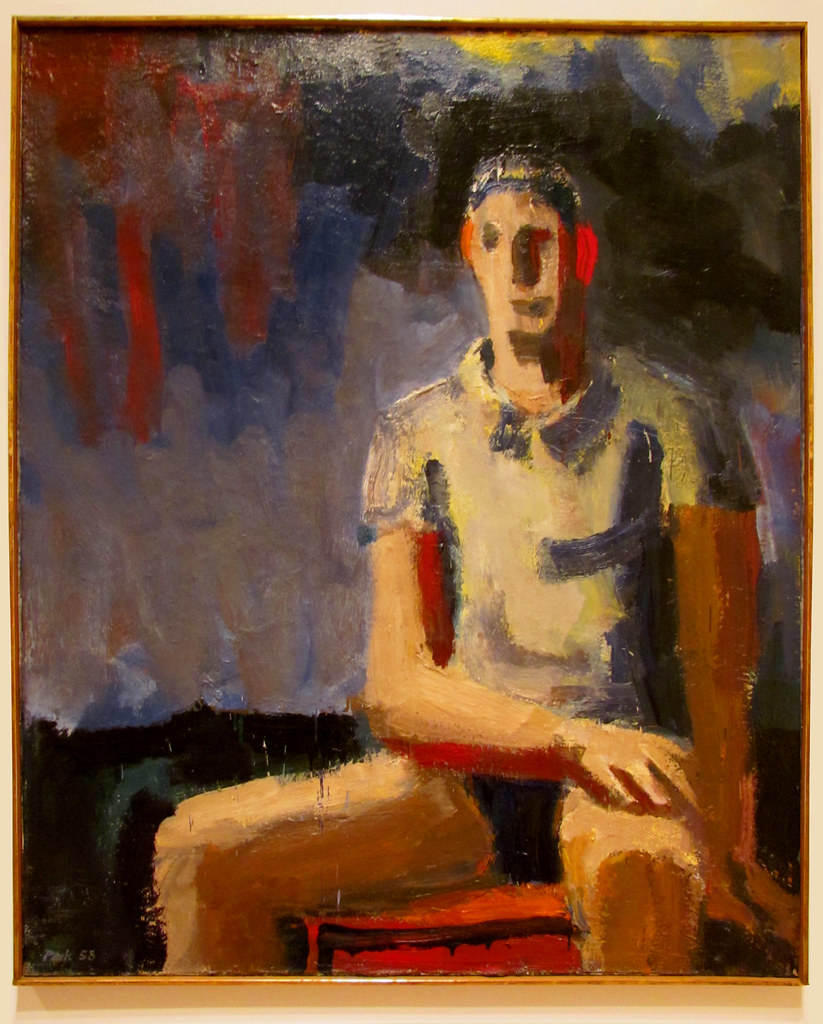
Richard Diebenkorn
Richard Diebenkorn (1922-1993) was born in Portland, Oregon; however, his family relocated to San Francisco when he was young. His mother was a lawyer and writer, providing Diebenkorn with a cultural environment. He always liked to draw, and the family cook even supplied him with art supplies. At Stanford University, he met his wife, and they married in 1943. Diebenkorn's education was delayed when he joined the marines as a cartographer and served until the war ended. He was stationed in different places with the marines; he studied art everywhere through museums or other artists. In New York, Diebenkorn experimented with abstract painting ideas, mainly influenced by the work of Robert Motherwell. As he was scheduled to leave for Japan, the war ended, and he returned to San Francisco. Diebenkorn wanted to continue his education and enrolled in the California School of Fine Arts (CSFA), a student of David Park, with whom he developed a lifelong relationship. Elmer Bischoff was also a teacher at the school, remarking on the talent of Diebenkorn as a star student. Diebenkorn spent a few years in New York before returning to California as a teacher at CSFA.
In 1950, he flew from Albuquerque over the open spaces to California, his first flight and significantly influenced his later paintings. Diebenkorn believed he had an artistic epiphany and stated, "… the earth's skin itself had 'presence' – I mean… It was all like a flat design-and everything was usually in the form of an irregular grid."[7] He saw the landscape as a series of flat planes, linear contours, and two-dimensional areas of changing colors. Diebenkorn believed in leaving a sparseness, empty spaces created by spontaneous lines. He spent the early part of his career in New Mexico, attending the University of New Mexico for his MFA. He used the views of the open spaces and unique colors of New Mexico as inspiration for his canvases before he returned to Berkeley, where he experienced his most productive and creative works.
As part of the original bay area group, Diebenkorn displayed his brilliance in pursuing the use of lines and the boundaries of his canvas or paper. He applied ink, gouache, and watercolor to form the interacting patterns seen in much of his work. He used lines in multiple combinations, moving and changing them until they created an interaction, alive in the painting. Diebenkorn's lines were flexible, meandering, modulated by the abrupt use of vibrant color. He wanted to paint the landscape, generally viewed from the air, a roof, or a window, using a single-point perspective to define the illusions of the space and buildings or humans within the spatial illusion. "Whether landscape, interior, figure, or abstraction, his world feels experienced and lived, and all of a piece."[8]
When Diebenkorn moved back to Berkeley, he noticed the rich greens of winter in the bay area, quite different from the sienna and browns of the New Mexico desert. In his beginning series of Berkeley, his palette became more vibrant. A close-up of Berkeley #47 (6.4.3) demonstrates the broad brush of Northern California landscape colors. He did not use hard or dark lines letting colors flow into each other and define their own spaces. His initial set of landscapes was abstracted to resemble aerial images of farmlands, mountains, or shorelines. He also incorporated some of the ideas of Abstract Expressionism while maintaining his understandings of landscapes.

The Seawall (6.4.4) portrays the California coastline and is considered one of Diebenkorn's best examples of the aerial view as some sections appear close-up. His saturated tones demonstrate the luxuriant colors of the meeting of farmland against the cliffs and foaming ocean. The painting accentuates the flat planes of color forming their meandering lines. Diebenkorn stated, "one wants to see the artifice of the thing as well as the subject. Reality has to be digested; it has to be transmuted by paint. It has to be given a twist of some kind."[9] He painted the image in his studio while capturing the sensory feelings of the changing coastal views.
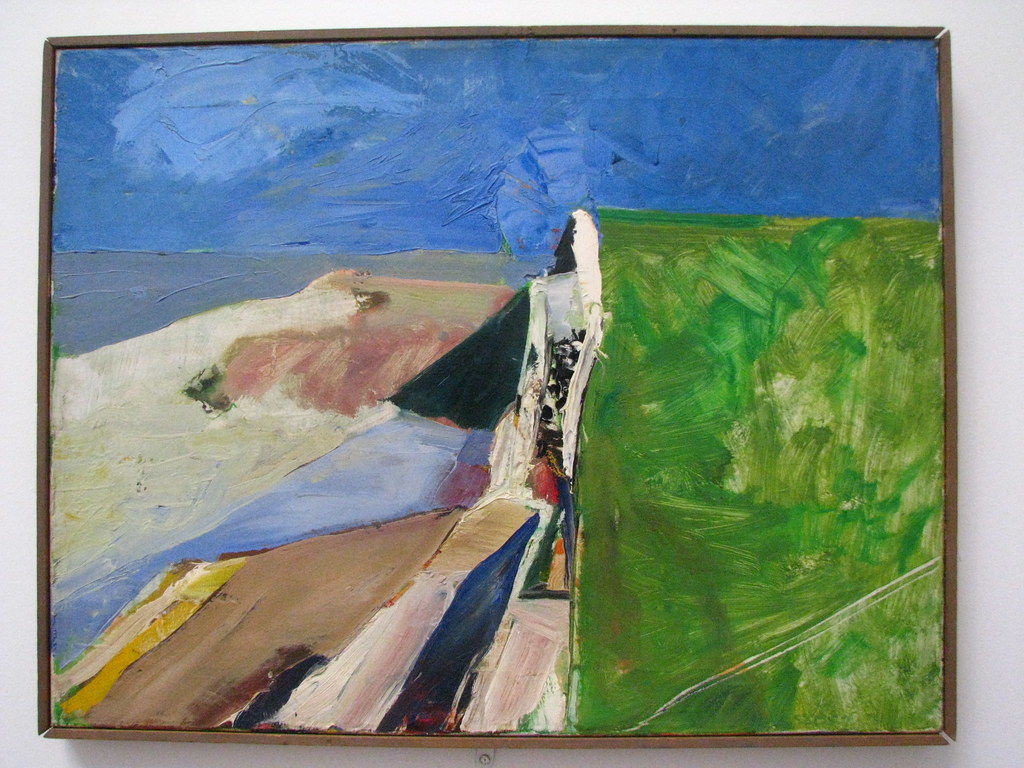
Diebenkorn used the boundaries of line and color to define interior or exterior rooms with the walls, floors, and vistas converging into the same spatial result. A person is generally incorporated into the room, furniture placed at diagonals or other angles. In Figure on a Porch (6.4.5), the surfaces appear flat, yet the ocean's deep blue suggests the steep drop from the grassy region, the matching far cliffs in the background. Horizontal planes of contrasting orange, green and blue are punctuated by the smaller objects in white or black. Diebenkorn includes his ordinary chairs for dimension, while the figure moves vertically through most of the horizontal planes, developing the depth of the painting.
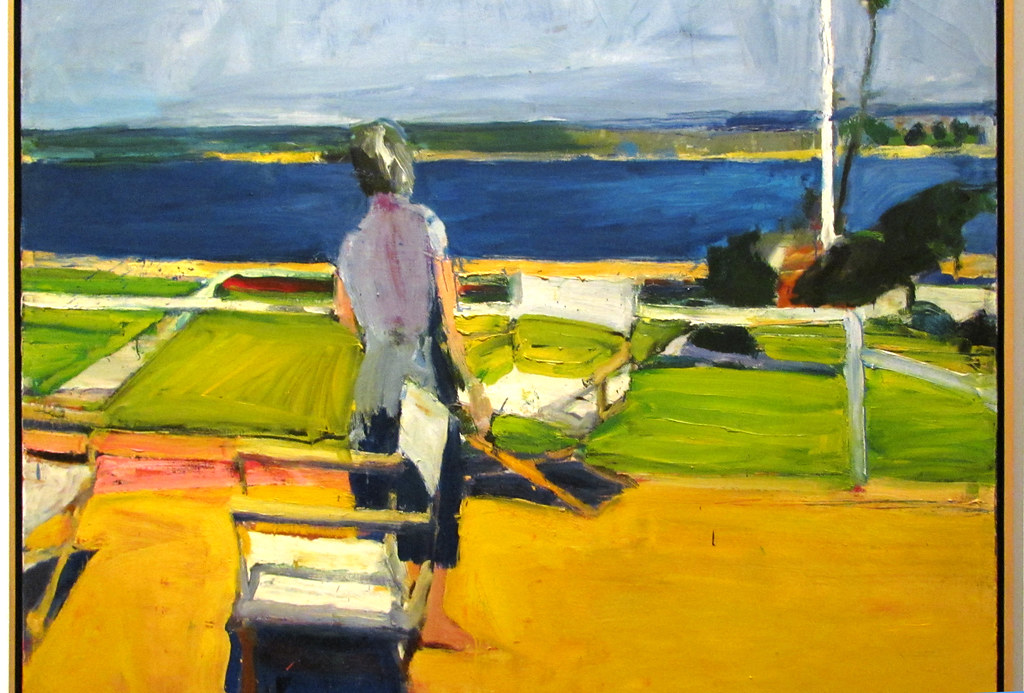
Diebenkorn moved to Los Angeles in the Ocean Park neighborhood, where his work became more abstracted as he created a series entitled Ocean Park. The lines and moving strips of color in Ocean Park No. 6 (6.4.6) appear as the eroded land seen from an airplane. The dry Southern California fields and hills are divided by diagonals, curves, and color into empty farmland before descending into the ocean. Ocean Park No. 6 is the first in over one hundred paintings in the series. Even in this image, Diebenkorn remains true to his themes of figures and rooms in the form of a landscape; the bent lines present a person's feelings, and the oblique angles suggest the idea of a room. Unhappy with the first five, he destroyed them. The series reflected an unknown region as a view from above, using light, color, space, and lines to define the vagarities and vestiges of the landscape.
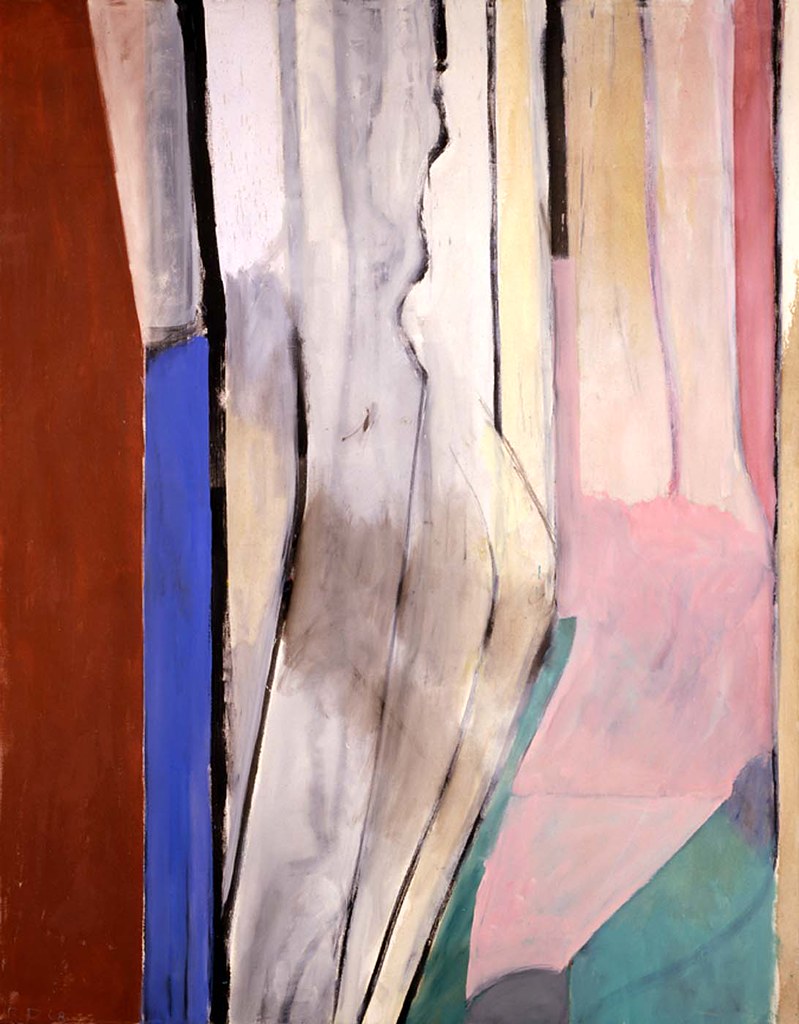
Figure \(\PageIndex{6}\): Ocean Park No. 6 (1968, oil on canvas, 123.7 x 182.9 cm) by americanartmuseum, CC BY-NC-ND 2.0
Elmer Bischoff
Elmer Bischoff (1916-1991) lived in Berkeley, California as a child, his parents valued the arts and music, and he attended the University of California, where he received an MFA in 1939. During his time in school, he studied Picasso's style, often painting in the same methods. Stationed in England during World War II, Bischoff served as an officer in the intelligence services. After the war, he returned to San Francisco and encountered the energy of different artistic expressions. He started to teach at the California School of Fine Arts, meeting David Park and Richard Diebenkorn, becoming part of the core group to start the Bay Area Figurative artists. Their studios were near his, and as they developed a camaraderie, the new ideas in art grew; paint became thicker, the images were less structured and freer and based on blocks of color and interspersed lines, moving from pure abstraction to figuration. Bischoff's and the others' work were considered bold, radical, and unrestrained. Early exhibitions in the 1950s gave Bischoff commercial success and set many of his paintings as interior landscapes with lush brushstrokes laden with paint. As he moved to figuration, he wanted to impart emotions instead of an elaborate definition of a scene. He continued to teach in California and New York.
The Orange Sweater (6.4.7) demonstrates his use of different cool colors to create light, filling the expansive space as the single person sits at a table in an orange sweater, slightly off-center, the focal point in the painting. The foreground displays horizontal lines forming the bench and tables; the strong lines of the windows, with the appearance of a storm outside, create drama against the interior's softer walls. Bischoff used varying hues and tones of similar colors with dramatic brushstrokes to depict the different planes of the walls and give depth to the room. The figure appears focused downward, moody, isolated; another figure appears in the background, watching.
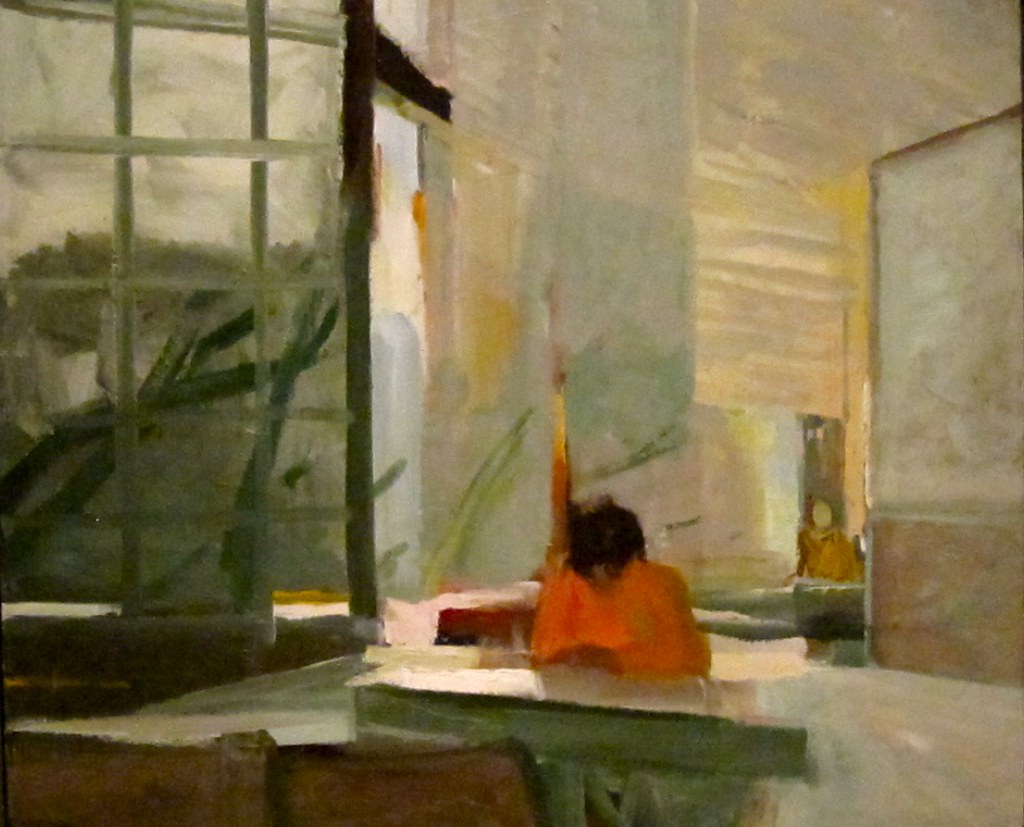
Bischoff's painterly methods were seen in the figurative elements of the Two Bathers (6.4.8). The thick impasto style creates the movement to an otherwise stillness. The different, competing colors of red, green, and cool blue develop into distinct figures in the minimally defined landscape constructed with thick brushstrokes. The two women stand far apart, illuminated by light against the strong contrasts of the landscape, enhancing the unknown tension between them. Bischoff and the bay area artists challenged the concept and ideals of abstraction to express the figure and its emotions.
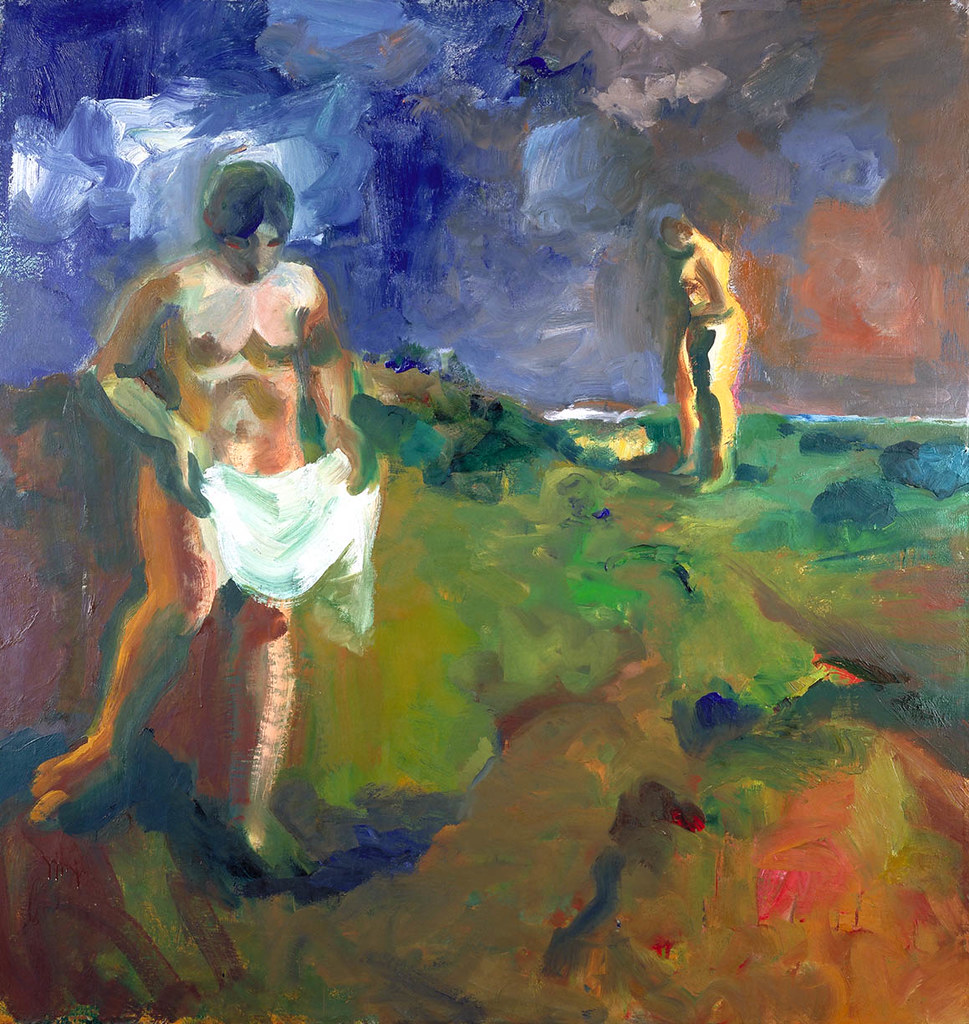
Figure \(\PageIndex{8}\): Two Bathers (1960, oil on canvas, 172.7 x 164.2 cm) by Gandalf's Gallery, CC BY-NC-SA 2.0
Wayne Thiebaud
Wayne Thiebaud (1920- ) was born in Arizona, and the family moved to Southern California when he was a child. As a teen, he worked as an apprentice at Walt Disney Studios and then as an artist for the Army during World War II. Thiebaud received his BA and MA at California State University, Sacramento, and taught art at the University of California, Davis until 1991. In the 1950s, he went to New York City and was influenced by the abstractionists and the new pop artists. When he returned to California, he claimed he painted illusionary art forms. Although his work may have been influenced by the repetition of Andy Warhol or the commonality of Edward Ruscha, his focus turned to objects found in diners or cafeterias. One of his signatures was the use of shadows by the application of heavy pigment along with exaggerated colors. In high school, Thiebaud helped with theatrical productions controlling the spotlights, a technique he used in painting. As a teen, he worked at the Mile High and Red Hot café, a diner noted for their displays of pies and hot dogs, themes frequently used. In 1957, at a show of the new Bay Area Figurative painters, Thiebaud saw the work of David Park, Elmer Bischoff, and Richard Diebenkorn, paintings that became particularly impactful on Thiebaud.
The Bay Area Figurative styles influenced Thiebaud's work; however, it is loosely associated with them. He worked on all sizes of paintings and surfaces in multiple mediums, including painting and printing, generally using oil paint, pastels, and occasionally charcoal. Many of Thiebaud's still-life works might be classified as delicious, the rows of cakes or pies, stacks of hot dogs, or deep red candy apples. He thought of food as more than something to eat, stating: "You take a lemon meringue pie. It's quite a beautiful thing…. It's more than just a subject, it's also a kind of relationship to the paint itself. You really feel like you're sort of making the meringue and …working with the pie."[10]
In Cakes (6.4.9), each cake is unique, the thick, dense paint forming the realistic frosting. The cakes are aligned in repeating rows, each cake outlined with a unique shadow. Mixed multiple colors create different lines and blended frostings. The cakes are placed on a single pole, the illusion of balance of the elevated cakes appearing real, a trickery of paint.
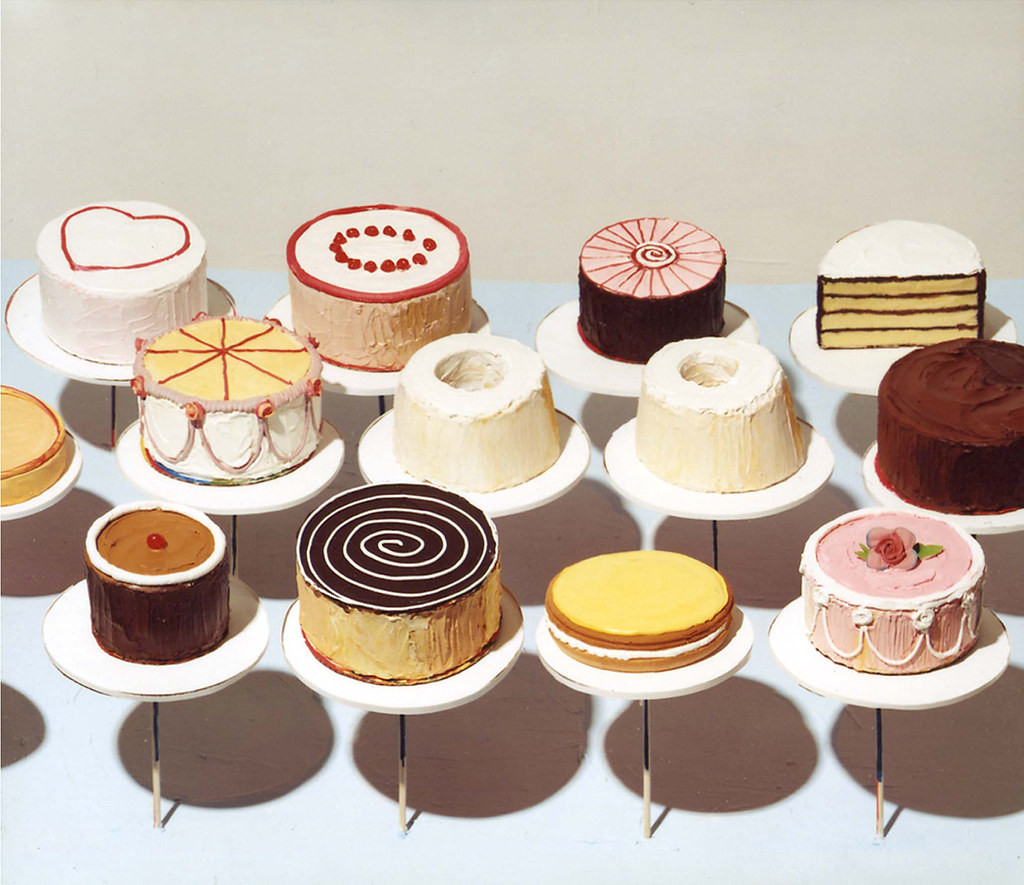
In Thiebaud's work Boston Cremes (6.4.10), the individual triangular segments appear covered in a thick gooey frosting. The two yellow layers of the cake appear as parallelograms stacked on top of each other and broken with the thin line of brown frosting. They are aligned on the beige counter created with deep horizontal brushstrokes and edged with different red, blue, and green shades, defining each one. The round cherry on the top of each cake pulls the eye along and across the rows, giving the repeated patterns a unique feeling.
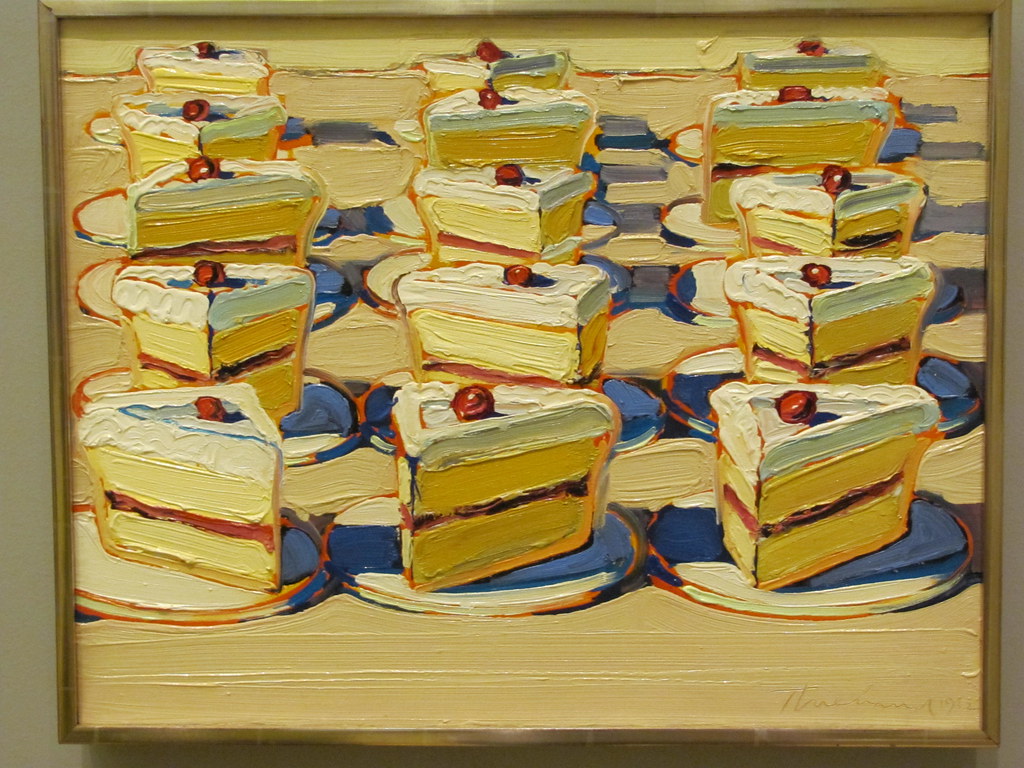
Thiebaud worked in several genres, including figures, landscapes, and still life, a concept he labeled as "people, places, and things."[11] For his figures, he followed the same patterns of color and minimalistic images. Two Kneeling Figures (6.4.11) is reminiscent of how he aligned his pastries. The two women are side by side, resembling the cakes on a stand as their bathing suits represent the cake, the upper part of their legs the stands. They each have his traditional deep blue-gray shadows indicating the light source. However, the light shines differently on each face as the woman in the blue suit has a little shadow, while the woman in the yellow-orange suit has a distinctive shadow on her face matching the shadow on the ground. Thiebaud uses a simple, monotone background; the horizontal line delineates the sand from the sky, the dimensional figures thrust forward.
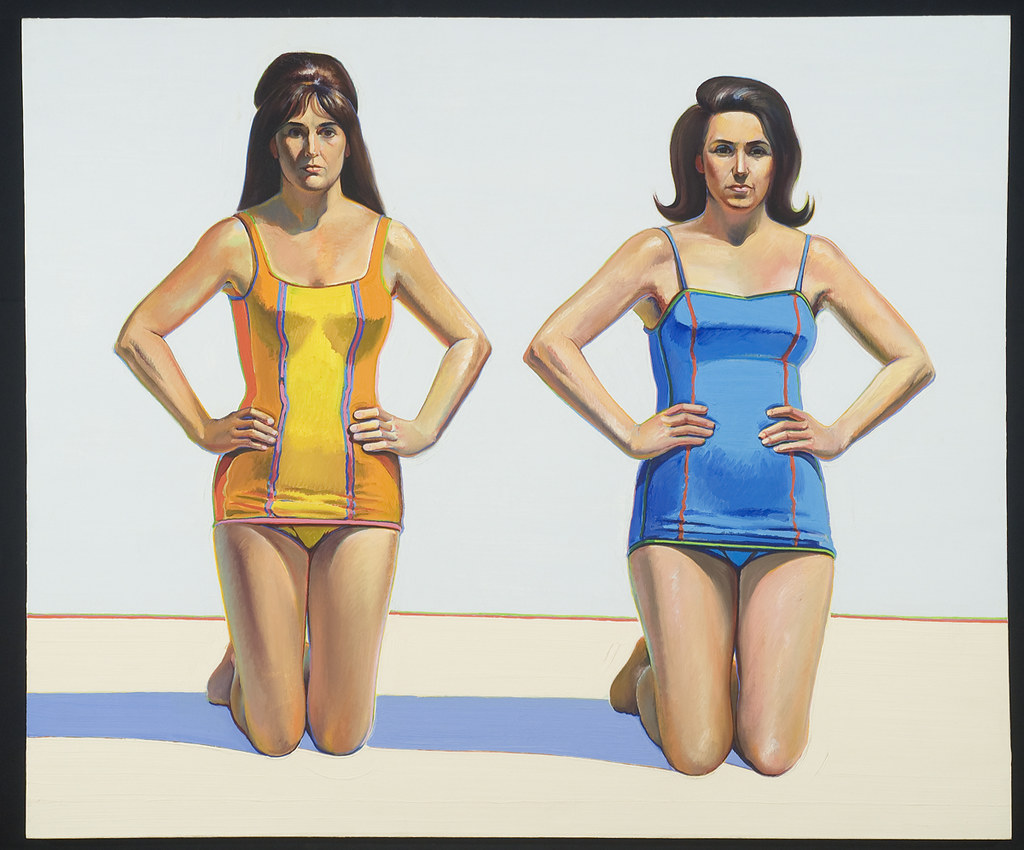
Betty Jean was Thiebaud's wife of over 50 years. He used her as a model in multiple paintings and mused how she was a 'good sport' to sit patiently for him. Betty Jean Thiebaud and Book (6.4.12) was one of his early paintings. The palette for the work was subtle; the neutral background and table established by the orange horizontal line provide a calm space for the resting figure. A woman reading a book is a common theme for artists throughout history. In this image, Thiebaud portrays his wife casually leaning on the table while looking at the audience. Her dark hair and dress contrast against the plain background as the book lays open on the table, reflecting the same color palette as the figure. No words are seen in the book, only a large picture on each side.
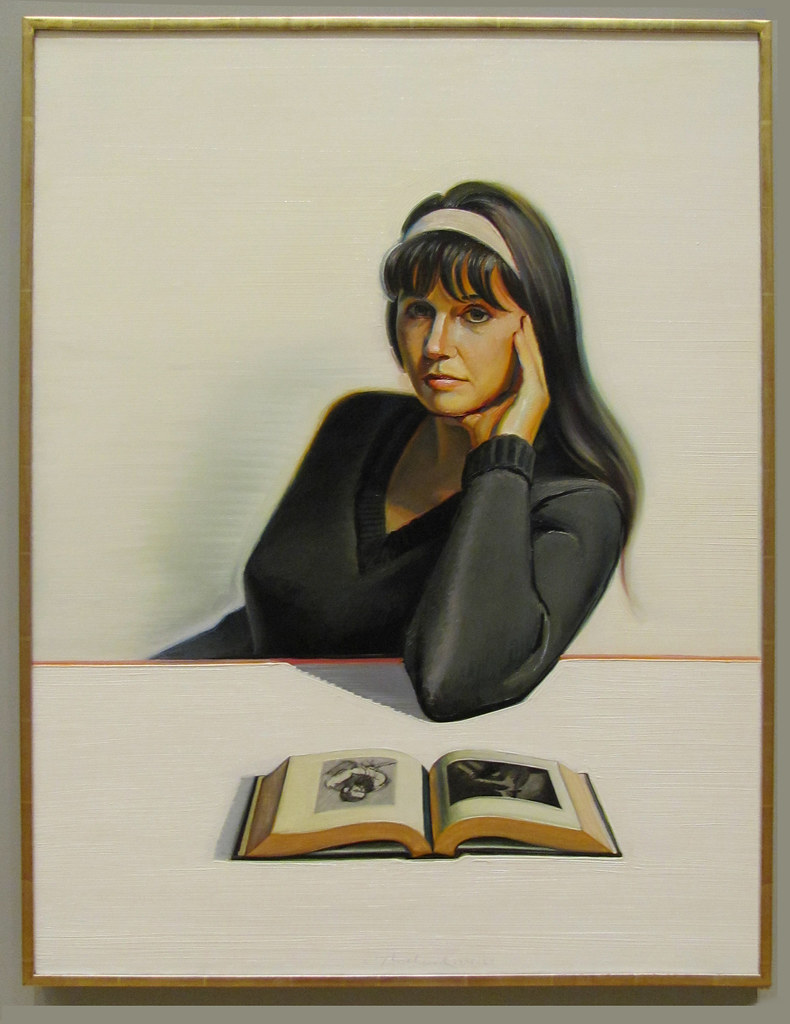
Nathan Oliveira
Nathan Oliveira (1928-2010) was born in California; his parents were immigrants from Portugal, and they separated when Oliveira was a toddler. He lived in San Francisco near Haight and Ashbury Streets with his mother, grandmother, and aunt, all of whom worked, leaving him isolated and lonely, feelings frequently seen in his artwork. Even as a child, Oliveira's ability to draw was evident, and after he graduated from a local high school, he attended the California College of Arts and Crafts, receiving a BFA and an MFA and was associated with Elmer Bischoff and Richard Diebenkorn. In 1951, Oliveira married, had three children, and as they struggled to pay bills, he frequently asked his wife, "Well, how many tubes of paint can I get this week—one of red, or two of yellow?".[12] Oliveira taught at multiple colleges, including the University of Chicago, UCLA, and Stanford University, teaching at Stanford for thirty years. Oliveira originally started following a painting process analogous to the Abstract Expressionists. He applied colors randomly until an image began to form, a sense of looseness he used for years. As the artists in San Francisco unchained themselves from New York's abstraction standards, they based their work on life's experiences. Oliveira explored the human figure, solitary in nature, emotions expressed in paint.
He worked with numerous media and subject matter types during his long career, including oil and acrylic paint, ink, clay, bronze, lithographs, and etchings, initially starting his career in lithography. Oliveira favored paint, a malleable material, easy to change hues, extending from dark to light to bring the figure to life on the canvas; however, he was also a skillful sculptor. He applied paint to the canvas, spontaneously developing the figure with multiple layers, as the emotional image emerged from the canvas. He applied paint in large globules, running the brush to form deep textures. Oliveira thought the natural light emitting from a figure was important, stating, "Figures must have their own light, it wasn't light that struck a figure in a certain way—the light itself, the luminosity was in the figure. It emanated from the paint itself."[13] The internal luminosity of his figures created the feelings of alienation or loneliness found in the paintings.
In Oliveira's early paintings, he positions the figures in the concept of a room. Adolescent by the Bed (6.4.13) depicts the image of a young girl beside an empty bed, her arm laying on the bed frame. Her expression delineates her discomfort, the dark paint dripping down her legs, leaving the viewer to wonder what happened to her on the bed as she gestured towards the bed. Oliveira used bold contrasting colors of red, white, and blacks to heighten the emotion.
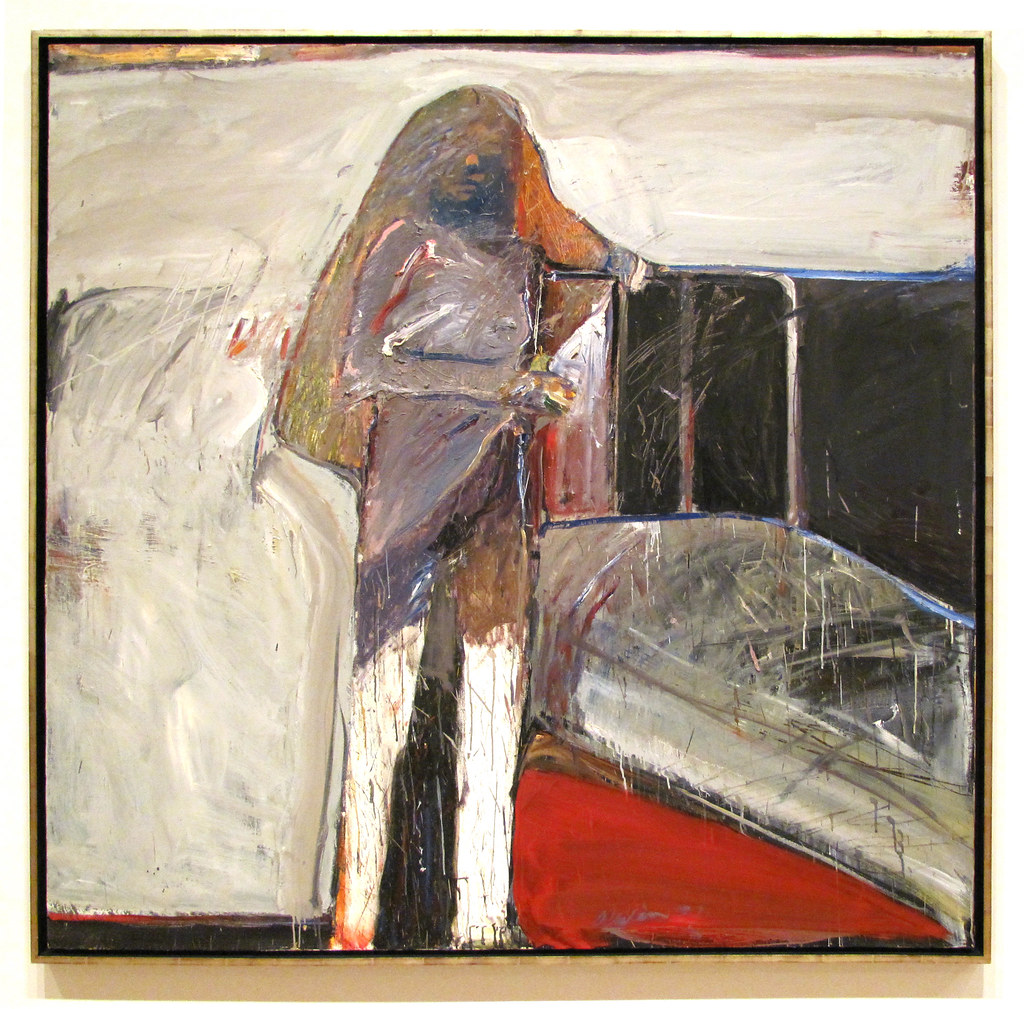
Nineteen Twenty-Nine (6.4.14) is an image of Oliveira's mother he painted from the musings of his childhood memory. She worked at night singing in local cafes and probably dressed in sultry clothing. He used multiple conflicting colors representing a time shortly before the stock market crash in 1929. During this period, Oliveira was experimenting with pigments and how to combine colors to create the emotional feeling of the individual. The dark, highly contrasted colors defined the floor and wall of the room, the figure positioned in the center. Her one flesh-colored hand brings a sense of her warmth as the emotions in her face are hidden behind ghost-like colors.
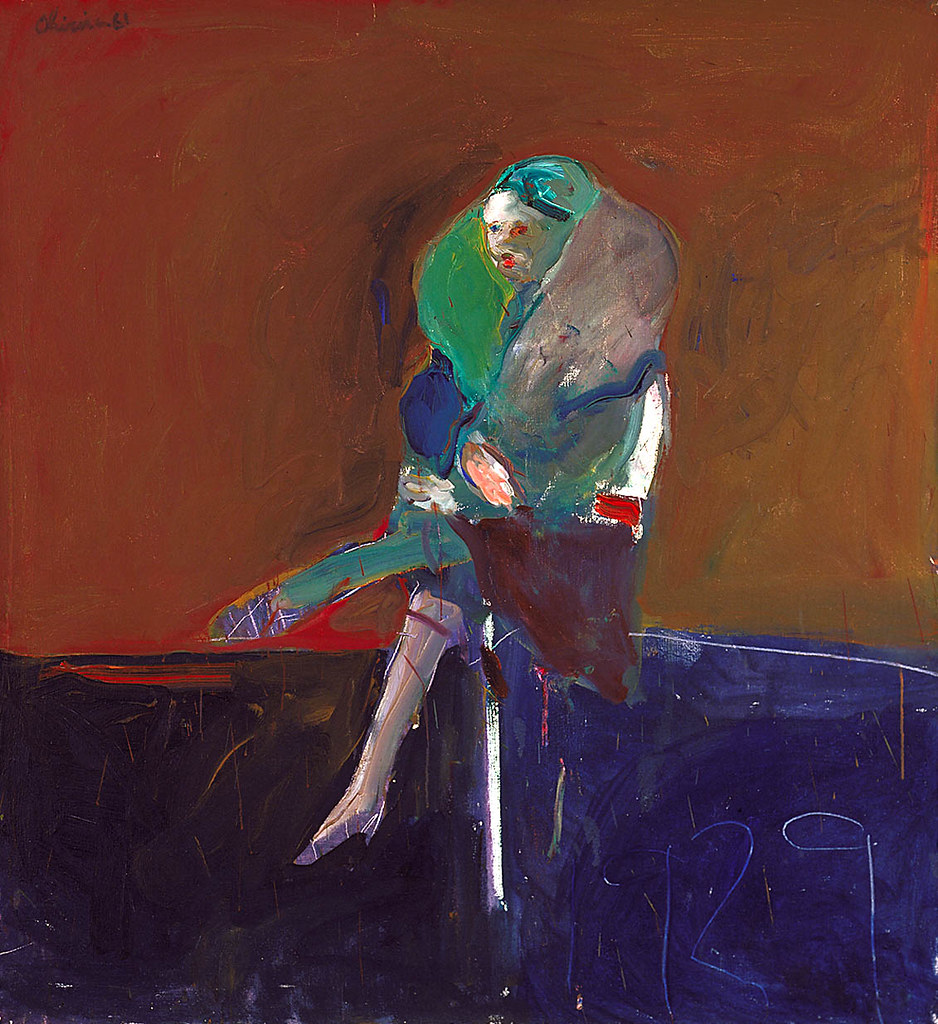
Oliveira created a dramatic series based on a solitary figure in exotic clothing moving across an imaginary stage with ambient space. Figure with Striped Leg (6.4.15) displays the figure whose diagonal, striped leg anchors the image, the upper body and face shrouded. The bright yellow shoe centers the foot on the stage as the colorful diagonal lines move the viewer towards the face and the mystery of the person's emotions. The orange background aura surrounding the figure projects the completed movement of the dancer. Oliveira spent many years teaching, creating prints, or using watercolors in addition to his works in oil. Early in 1960, he experimented with sculpture before returning to his favorite medium. In the 1980s, former students encouraged Oliveira to investigate sculpture, and they helped him construct a workshop to accommodate the materials. He started by sculpting heads and small female figures before moving to his full-size statues, sculpting a series of numbered female images. The figures were long-legged, similar to his painted females, each posed in seemingly uncomfortable positions.
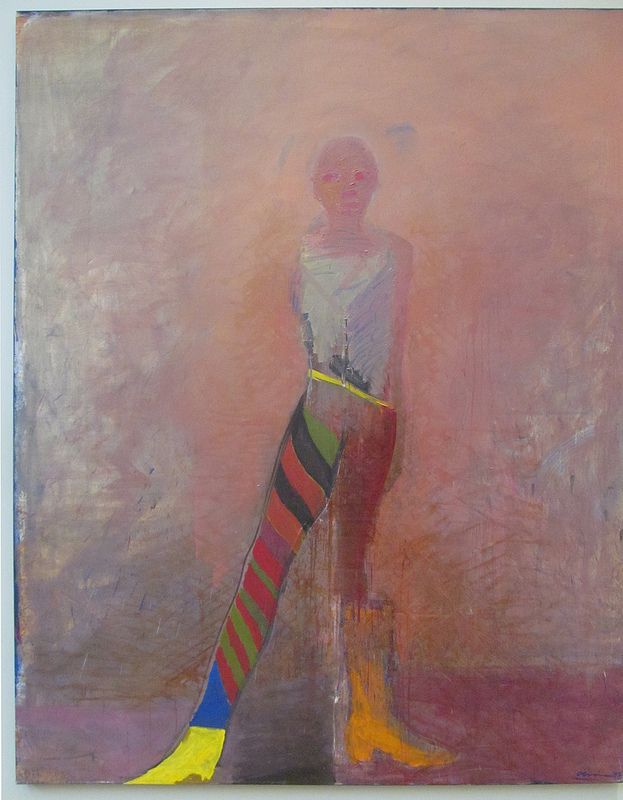
In Figure Three (6.4.16), her long, slender neck is thrust forward, and her arms are awkwardly held behind her back. The expression on her face is hidden; is she melancholy, reflective, or just viewing her surroundings. Although she is bronze, she is covered with a patina highlighted by brushstrokes Oliveira used to cover her. He believed he was a painter who made sculptures, and adding color to the statue enhanced the intensity of the emotional figure.
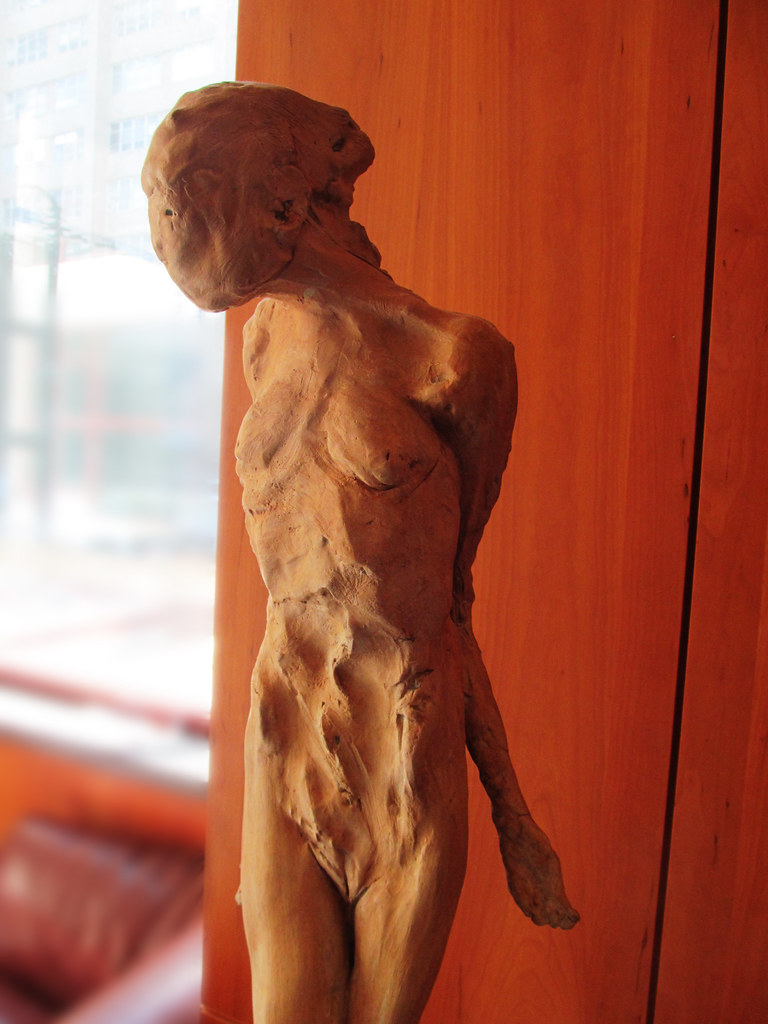
Joan Brown
Joan Brown (1938-1990) was born in San Francisco into a family with an alcoholic father and an unhappy mother. Her early education was through the Catholic schools in the city. When she found an ad for the California School of Fine Arts, she applied to avoid going to the religious school her parents preferred. She received both a bachelor and master's degree in art, meeting Elmer Bischoff, who became her inspirational instructor and mentor. She married a fellow student, Bill Brown, in 1956, a marriage which was annulled in 1962. She subsequently married Manuel Neri, with whom she had a long-term artistic collaboration, from 1962 to 1966. Bischoff taught her to believe in her feelings and inspiration, not worry about academic rules, and explore and believe in her abilities. Brown's early works focused on Abstract Expressionism, and her first show in New York brought her immediate attention. The style did not fit her artistic visions. Brown started to focus on more representational images based on her lifelong passions and interests; her family, pets, swimming, dancing, and later in life, she developed spirituality and interest in ancient cultures.
Brown focused on the expression of the body and how it moves, placing the figure in an interesting setting. Simultaneously, she developed a bright, intense color palette applied with palette knives or large brushstrokes. Although she was associated with the Bay Area Figurative movement, "Brown herself was never concerned with such discussions and issues for, ultimately, the painting was a very private undertaking for the artist-and ultimate devotional act in which she reflected upon her relationship to the world-at-large and the spirit within her."[14] Brown taught at several universities and colleges in the bay area, including the University of California, Berkeley. She inspired her students to believe in their artistic instincts, not the commercial world or different movements and defined styles. Brown was not interested in, or part of, the women's movement or any feminist agenda; she thought participating in any movement might trivialize her views of art and personal expressions. As she grew older, Brown studied spiritual ideals and traveled multiple times to India, creating sculptures reflecting icons of ancient cultures. In 1990, she was overseeing the installation of her obelisk in India when the concrete tower collapsed, killing her and two others.
Brown's focus on autobiographical scenes frequently included her son Noel whom she had with Manuel Neri. Despite the problems of motherhood, she used a spare bedroom as a studio and generally painted at night, her young son a freeform model. Noel in the Kitchen (6.4.17) portrays Noel in the kitchen of her home in San Francisco, where he is exploring. A genuinely domestic image as Noel is reaching for something on the counter, the dishes piled high, the two dogs waiting patiently by the boy. With a trowel, Brown used a concentrated palette of primary colors, and in the painting, repeated squares and blocks of color; the black and white dogs stand out against the red cabinet. She includes specific details in the image, the dog's collar, Noel's bottom, the handles of the pans, or the small red cup, all bringing movement and reality to the painting. The image was true to life; the boy's pants are coming off, the dishes need to be washed, the floor and walls a little dingy. Brown wanted the backgrounds to be as important as the main objects explaining; "Looking back I can distinctly remember feeling very strongly about the background not just being a background, or backdrop for the figure, but believing that it was every bit as important physically as [the imagery] in the foreground."[15]
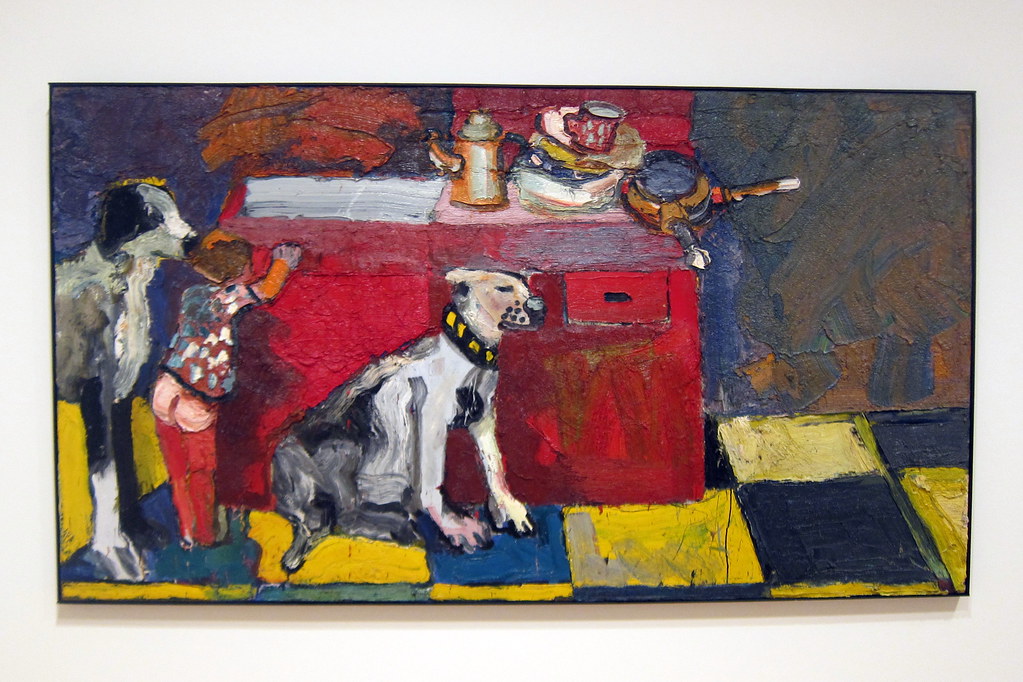
Brown and her then-husband, Gordon Cook, shared an interest in dancing and frequently dressed in their finery, ate at local restaurants, and danced to the melodic music of the forties and fifties. She painted a series of images of dancers, including Dancers in a City #2 (6.4.18). Brown added the dark, delineated skyline as the background behind the large red floor made with typical squares. The feel of the music dances across the bottom of the painting, adding to the beat of the moving figures. Her partner is sketched in, almost similar to a cartoon character. She generally added unusual or out-of-place elements, as seen in the dog by the dancers. Brown frequently added animals to her paintings, believing she found human characteristics in them, dogs her favorite animal, a protector.
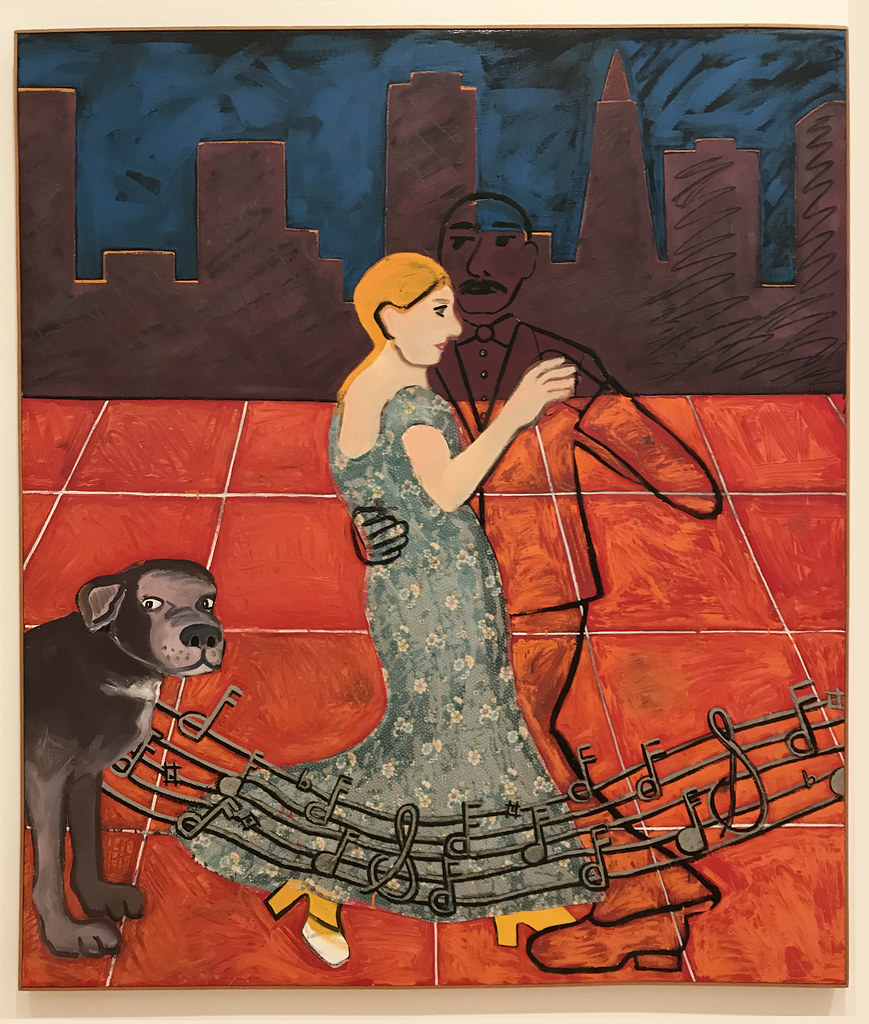
Brown created multiple self-portraits, all personal to her life and feelings, some illustrating the results of different events. After the Alcatraz Swim (6.4.19) reflects her harrowing experience of swimming across the bay from Alcatraz to the shore. Swimming was an essential part of her life, and she spent a lot of time swimming in the cold waters of San Francisco Bay. Along the bay shoreline were rowing clubs that catered to men only, no women allowed, forcing the women to change in the public restroom or their cars. Brown joined other women, and they won a class-action lawsuit because of sexual discrimination; the clubs had to allow women in their facilities. In 1975, she entered the annual swim from Alcatraz; many people, including Brown, struggled with the problematic currents and wakes of the freighters. Brown had to be extricated from the water before reaching the shore because of hypothermia and disorientation. The experience was traumatic, and she painted a series of portraits reflecting her experiences. In this painting, Brown stands by the fireplace, appearing calm as the wild waters of the bay swirl around her head in the painting above the fireplace, representing the absolute chaos of almost drowning. The following year she entered the race again, persevered, and finished the swim.
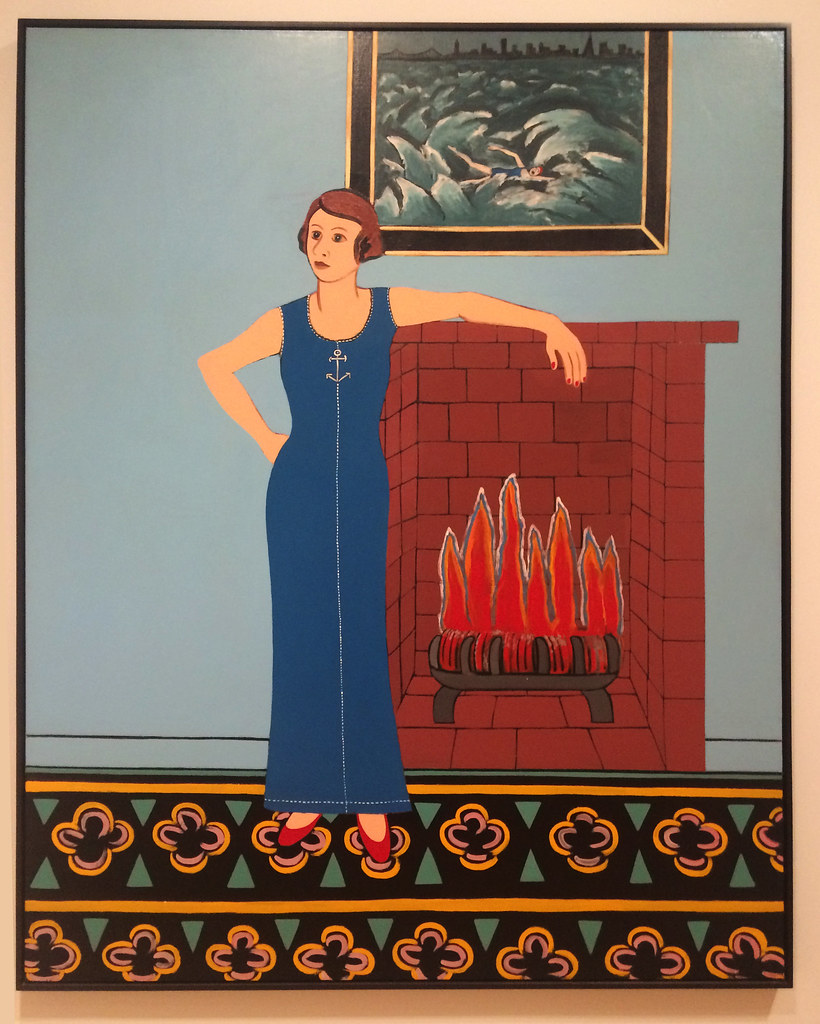
Figure \(\PageIndex{19}\): After the Alcatraz Swim #1 (1975, oil enamel on canvas, 243.8 x 198.1) by rocor, CC BY-NC 2.0
Brown focused on her self-identity, her emotional feeling, and her physical appearance and painted multiple different versions of self-portraits. The diverse backgrounds and details of the images reflect the conflicting feelings women experience from expectations of beauty, dress, or size. She generally portrays herself looking forward as though staring at her image in a mirror. Brown said, "Looking in the mirror, becoming a spectator, literally describing myself, is a very graphic way of being introspective."[16] She painted many self-portraits, giving a window into her emotional and physical changes and development during her lifetime. Although Brown insisted she was not part of any feminist movement. Her large number of introspective portraits explored one woman's self-exploration through the concepts of the time.
Brown was known for the careless manner she used materials, including paint, which was habitually found on the floor, walls, furniture, and even large splats of paint in her hair or all over her clothing. In Self-Portrait in Fur Hat (6.4.20), she inexplicably dons a bedraggled-looking fur hat. The colors of the hat are the same as the background; the squares are a counterpoint to the wild straight strands of the fur. Her shirt is covered in paint, giving the appearance of an old paint shirt she was wearing. Her resolute cool blue eyes stare out of the portrait, surrounded by the light contrasting skin color.
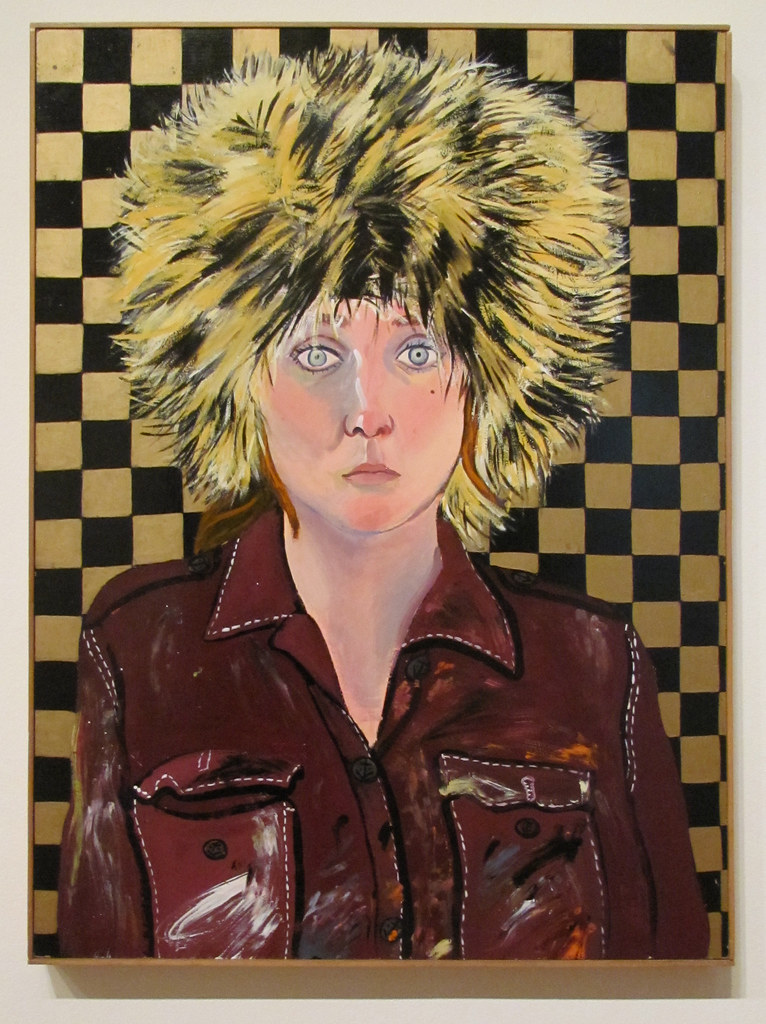
Self-Portrait at Age 42 (6.4.21) is one of the many birthday images she painted of herself. In this portrait, her eyes still look outward; however, they seem apprehensive, perhaps questioning that another year has passed. The background is plain, a darker shade of her dress, forming her face and hair as the central features.
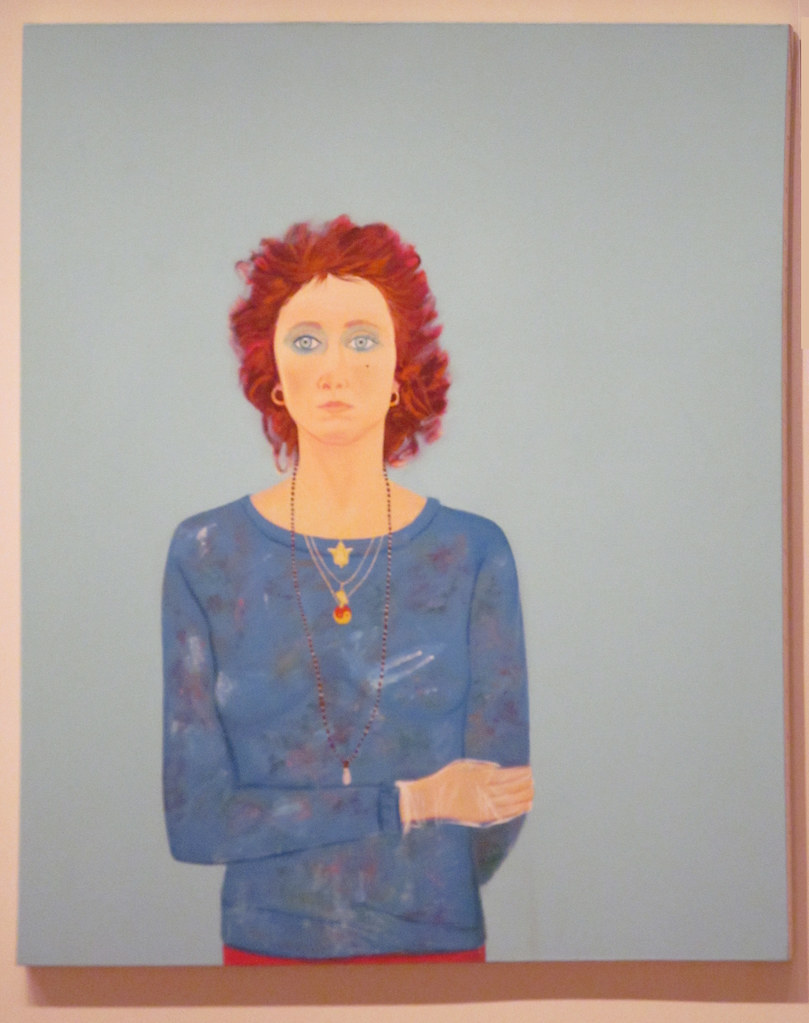
Manuel Neri
Manuel Neri (1930- ) was born in a farm town in California; his parent's migrant workers who fled Mexico during the Mexican Revolution. They worked in the farm fields, following the crops and hoping their son would finish high school. He successfully graduated from high school and went to San Francisco City College to major in engineering. After taking a ceramics class, he was inspired to pursue art. Neri transferred to the California College of Arts and Crafts, studying under Richard Diebenkorn and Elmer Bischoff. He planned to study pottery because he was told he could not paint. At the school, he explored sculpture and developed his method of using painted plaster, an inexpensive medium, easy to use, and paint. He created stacks of drawings for inspiration, the look of his figures similar to Oliveira with whom he developed a friendship. Neri also collaborated with Joan Brown for many years, marrying her in 1962. He taught at the California School of Fine Arts, UC Berkeley, and UC Davis for over thirty years.
Neri was long a part of the Bay Area figurative movement, creating partial elements of the attenuated female form, frequently incased with vibrant colors. In all the stages of his work, Neri consistently focused on the partial and fragmented figure. He generally started with a live model sketch and built the required armatures before bringing his figure to life in plaster or bronze. Neri focused on a single form, offset against the background as though another part was missing, and applied paint to enhance or diminish areas of the sculpture. Instead of following anatomical purity, he reinvented the figure through its lonely and isolated settings. Made of limestone or gypsum and sand, plaster solidifies and can be fired to create a lasting yet fragile object. Neri used plaster in methods similar to early Greek forms based on a ground or baseline for the figure and a minimally expressed background. The nude forms frequently had incomplete limbs, especially arms, one leg in an advanced position similar to the Greek kore. He believed, "missing limbs ennoble the form that survives, and lead us to revere all the more the value and beauty of the female form…"[17] Neri's sculptures reflect the sadness or joy of the human condition, the vulnerability of the figure. He thought a simple gesture, the tilt of the head or the bend in an elbow, gave emotion to the movement.
Over the decades, Neri made a series of different images of drawings and sculptures, the basic form unchanged with other textual elements and paint application. The female, as seen in Mujer Pegada Series No. 7 (Cast 2/4) (6.4.22), one of his later castings, seems to have her body immersed into the background painting. Neri used the words Mujer Pegada as a humorous play on words; in Spanish, they mean "woman stuck." Some of her body appears smooth, the female figure's perfect formation as other parts look rough, unfinished, her body incomplete, her hands behind her back. Neri applied different paint colors in light washes; the light background textualized, the figure in darker tones, all in loose brushstrokes. The large organic and abstract yellow shape floats on the wall as the ledge below grounds the figure. Neri's Mujer Pegada series presented the figure as transitory, imaginary or real, almost developed or fading from view.
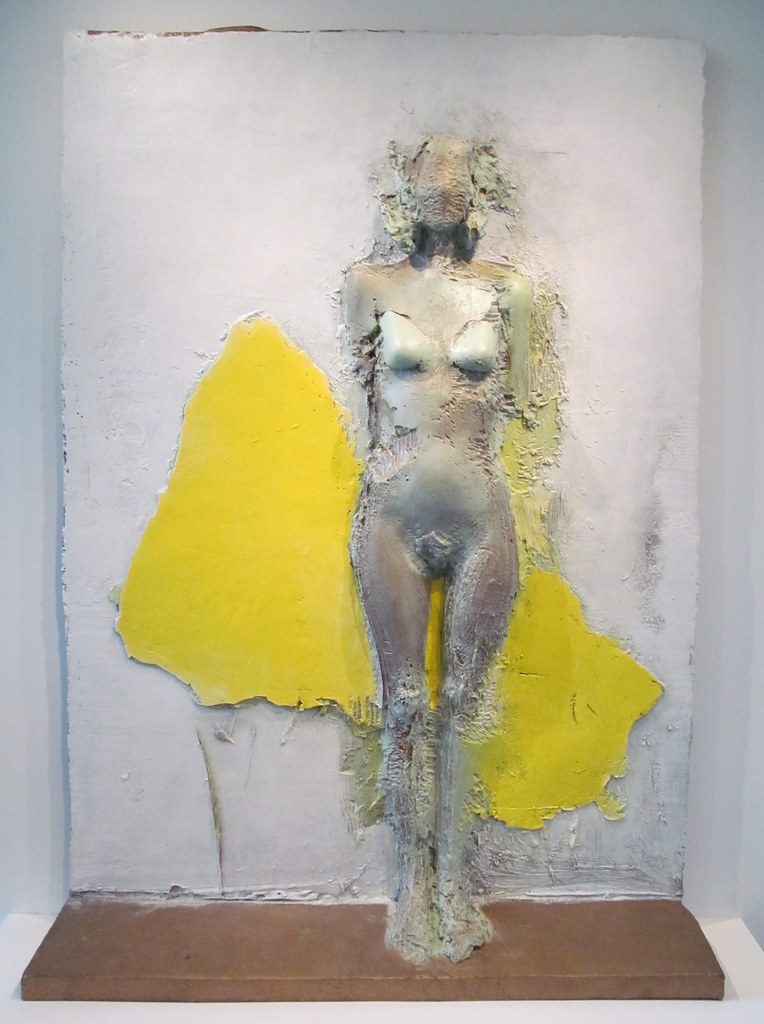
Rosa Negra #1 (6.4.23) is a bronze sculpture of a female form liberated from the usual background of emergent figures who are partially formed. In this series, the figure is standing, her body, arms, and legs complete, although roughly formed. Her feet sink into the platform, her fingers undefined, her face still hidden in the material. Neri used each figure as a blank canvas, forming some regions smoothly and cutting and hacking other parts. He used paint to complete the definition of the figure, yellow accenting the possibility of clothing.
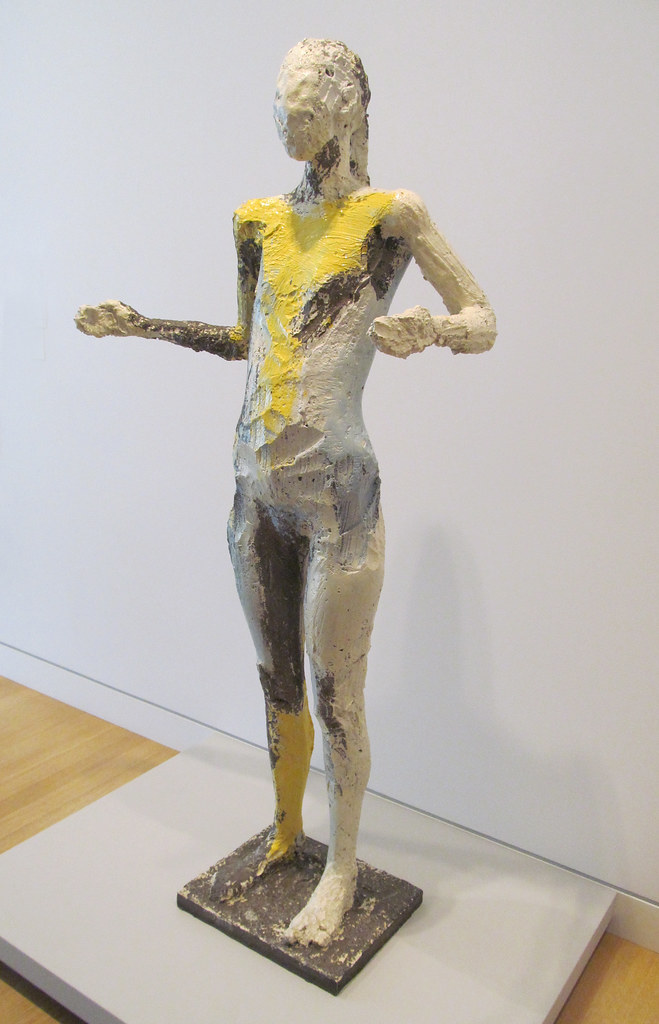
During the 1970s, a poet, Mary Julia Klimenko, started modeling for Neri, the beginning of a forty-year relationship. She became his almost exclusive model for the many figures he drew and sculpted during those years. She wrote poetry and read to him as he worked, inspiring each other; some say she was his muse. She was fascinated by his work as he threw plaster on the figure or used an ax to chip away at a limb, his studio full of plaster dust and crumbs, tools scattered on the floor, dripping plaster on a sculpture. Mary and Julia (6.4.23) is a play on the model's two names, portraying her as one person with different personalities, the complexity of Mary Julia's personality. The poses are similar, each with an arm extended and one laying on her knee, the faces showing diverse emotions, the interpretation left to the viewer. Neri also applied the plaster; differently, some areas smooth others rough, adding blue paint to one arm, enhancing the dissimilarity.
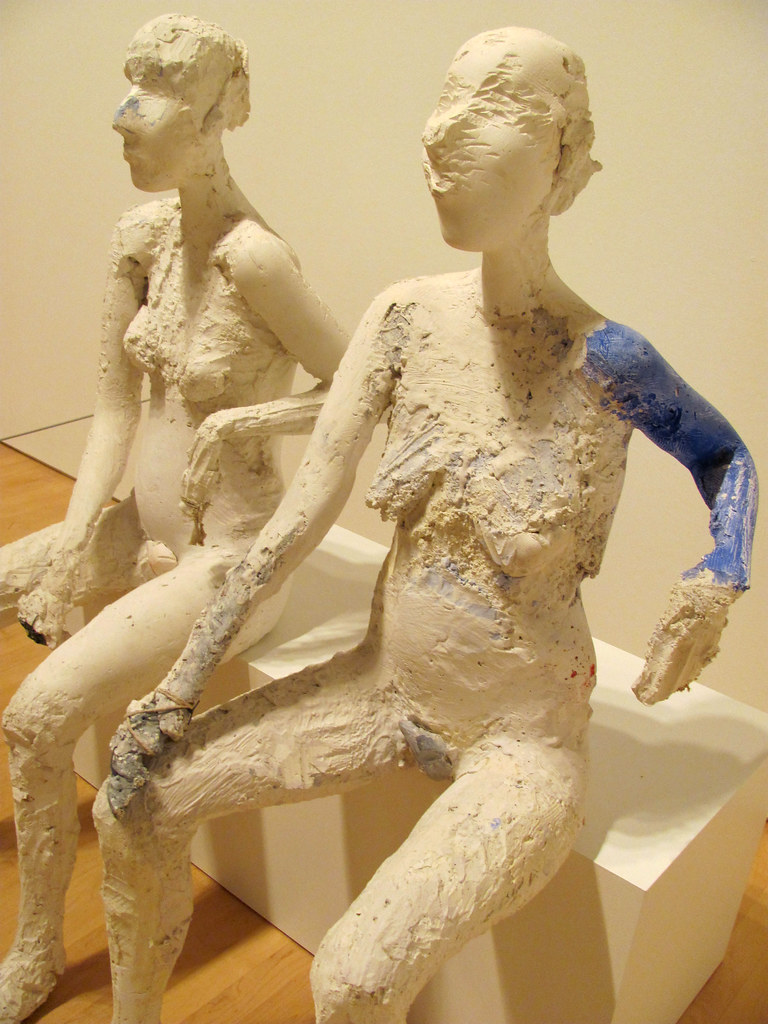
Untitled (6.4.24) is another of Neri's completely open sculptures, her face hiding any feelings, her position shrouded in multiple meanings. Roughly applied paint covers most of the work, perhaps the soft pink demonstrating her vulnerability.

Henrietta Berk
Henrietta Berk (1919-1990) was born in Kansas, moving to San Francisco as a child. She studied art at San Francisco State College as well as the California College of Arts and Crafts. Berk studied with Richard Diebenkorn at the college and was part of the Bay Area Figurative Movement artists. Berk employed many innumerable concepts using broad, heavy brushstrokes to apply the thick, brightly colored paint. Although she was well-known as an artist of the movement, she remains somewhat elusive in the general world.
The Valley, Vacaville (6.4.26) portrays the area before the housing expansion in the bay area out into the nearby farmlands. The view appears from a hillside, across the farmland, into the flat land surrounding the bay and the bay itself. Berk used bright shades of oranges and yellows for the fields and dark greens for the contrasting trees. In the background, the deep blue of San Francisco bay projects a horizontal relief before resuming the foreground colors in the sky. She used a limited palette, a feature found in most of her landscape paintings.
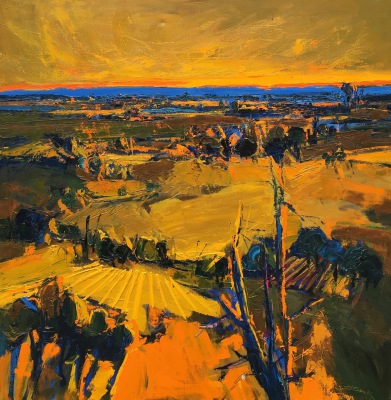
Yellow Still Life (6.4.27) again demonstrates her use of bright colors, thick paint, and deep brushstrokes. Berk applied the paint quickly, frequently using paint directly from the tubes. The painting is divided multiple times by the bold horizontal and vertical lines. The dark green and blue lines of the tablecloth anchor the wall's bright yellow, thick lines. She dissected the yellow space with the horizontal blue lines. The round oranges center the lower half of the painting as the dark blue flowers force the eye to the top half. Berk balanced the painting with lines, position, and color.
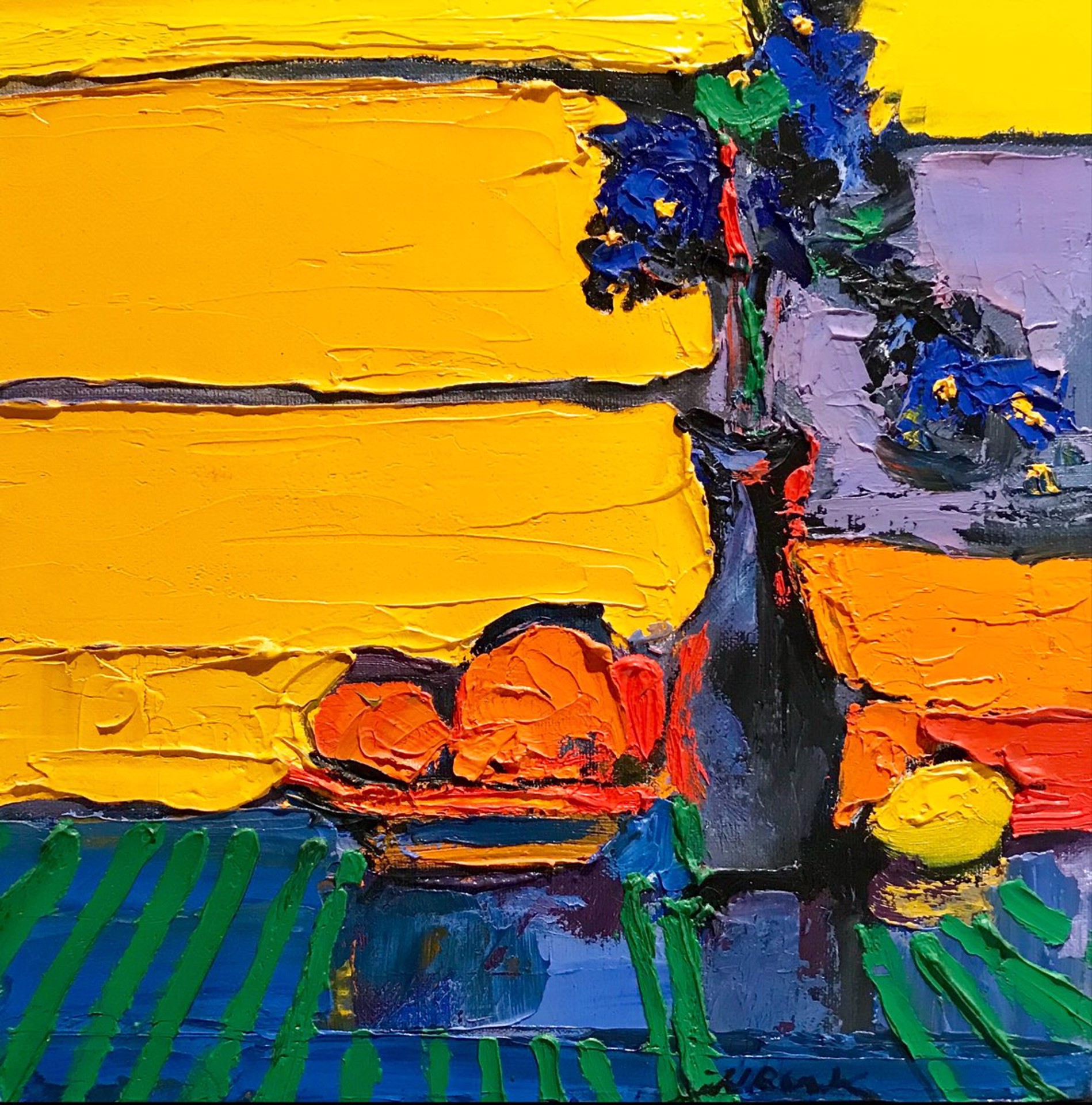
Berk was one of the Bay Area artists who introduced the human figure as part of their images. Vendors selling their wares could be found in many of the local communities and streets. Street Vendors (6.4.28) portray the vendor sitting behind his wares; the two people in the center appear engaged in conversation. Unlike many of her works where Berk used a limited palette, this painting is exceptionally vibrant with an extensive variety of colors. The dual blues in the background set the base for the multi-colored umbrella and the colors of the vendor's wares. As in many Bay Area Figurative painters, the elements are abstracted, viewed in the items the vendor is selling or the conceptualized images of the people.
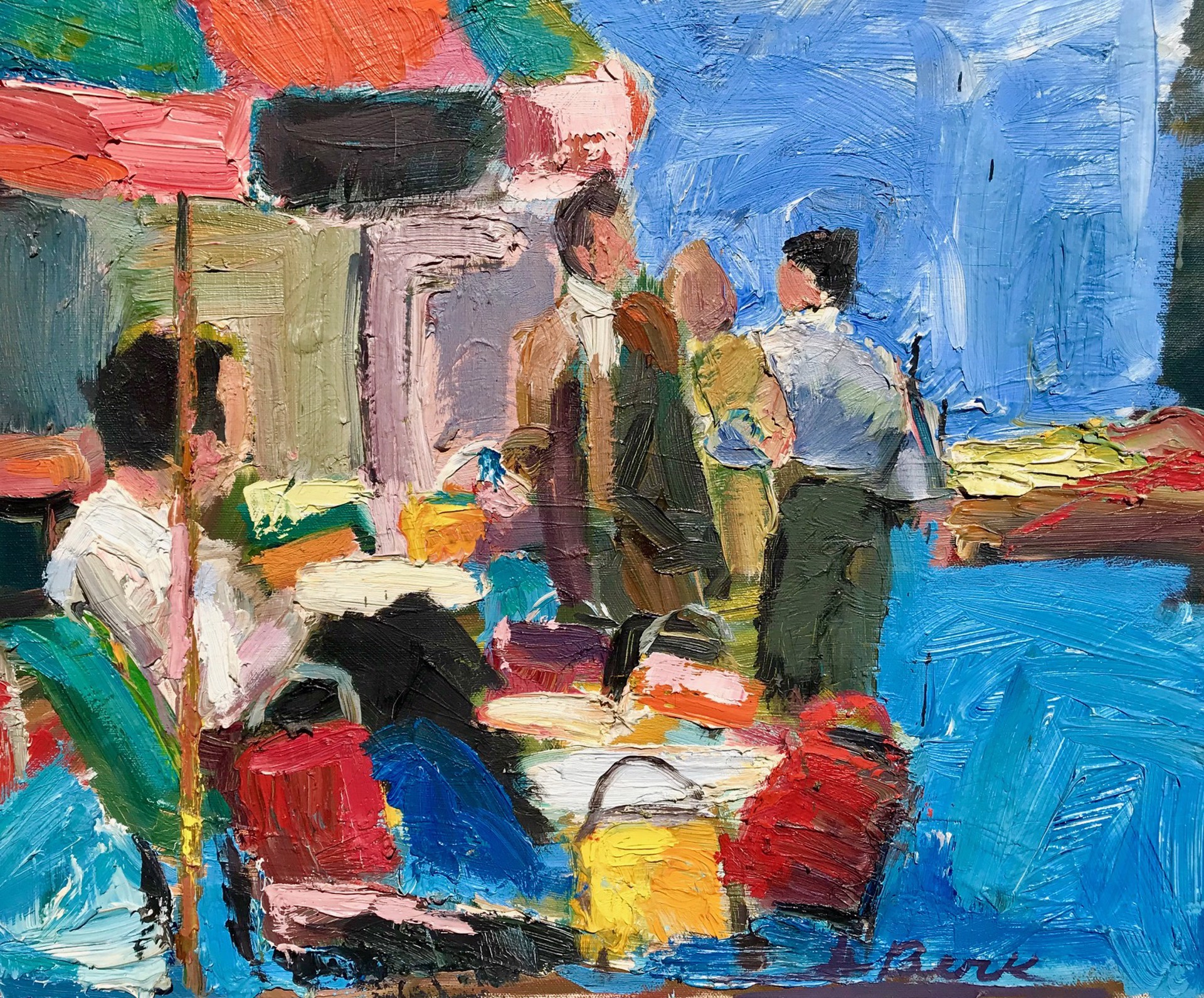
In Self Portrait (6.4.29), the only thing known about Berk is her hair is probably long as it is gathered on top of her head and fills the top half of the painting. The color may be brown or red; the use of a light source brings different perspectives. Her eyes are looking down, the color and shape unknown, the nose and mouth mere abstracted lines, a reflection of the thick paint she applied with quick brushstrokes.
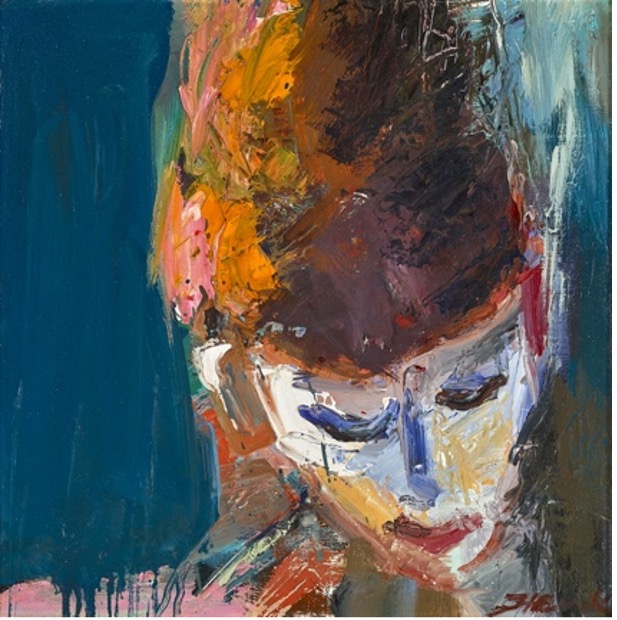 Figure \(\PageIndex{29}\): Self Portrait (1961-1963, oil on canvas, 40.6 x 40.6 cm) by Califpaint, CC BY-SA 4.0
Figure \(\PageIndex{29}\): Self Portrait (1961-1963, oil on canvas, 40.6 x 40.6 cm) by Califpaint, CC BY-SA 4.0The Bay Area Figurative movement was generally composed of three different groups: the First Generation (David Park, Richard Diebenkorn, Elmer Bischoff, Wayne Thiebaud), the Bridge Generation (Henrietta Berk, Nathan Oliveira), and the Second Generation (Joan Brown, Manuel Neri). The movement was viewed as the first significant change in the art based on the West Coast, instead of the trendy movements of New York or the more traditional abstraction of Europe based in Paris and Berlin. Although a significant amount of their works was figurative, they also painted the landscapes, seascapes, and cityscapes of the San Francisco Bay Area. Their works also influenced the rise of San Francisco jazz and the beat culture.
[1] Selz, P. (2002). Nathan Oliveira, University of California Press, p. 67.
[2] Williams, T. (2013). Drawings of the Bay Area School. Master Drawings, 51(4), 481-520. Retrieved May 17, 2021, from http://www.jstor.org/stable/43705969
[3] Tuchman, M. (1977). Richard Diebenkorn: The Early Years. Art Journal, 36(3), 206-220. doi:10.2307/776199
[4] Williams, T. (2013). Drawings of the Bay Area School. Master Drawings, 51(4), 481-520. Retrieved May 18, 2021, from http://www.jstor.org/stable/43705969
[5] Tuchman, M. (1977). Richard Diebenkorn: The Early Years. Art Journal, 36(3), 206-220. doi:10.2307/776199
[6] Boas, N. (2015). David Park and George Staempfli: A Painter and His Dealer. Archives of American Art Journal, 54(1), 46-62. doi:10.1086/683150
[7] Burgard, T., Nash, S., Acker, E. (2013). Richard Diebenkorn The Berkeley Years 1953-1966, Yale University Press, p. 70.
[8] Broun, E. (1999). Richard Diebenkorn's "Ocean Park No. 6". American Art, 13(2), 80-83. Retrieved May 26, 2021, from http://www.jstor.org/stable/3109300
[9] Burgard, T., Nash, S., Acker, E. (2013). Richard Diebenkorn The Berkeley Years 1953-1966, Yale University Press, p. 72.
[10] Retrieved from https://www.nga.gov/content/dam/ngaweb/Education/learning-resources/an-eye-for-art/AnEyeforArt-WayneThiebaud.pdf (5 June 2021)
[11] Retrieved from https://www.nytimes.com/2012/11/09/arts/design/wayne-thiebaud-retrospective-at-acquavella-galleries.html (7 June 2021)
[12] Retrieved from https://news.stanford.edu/news/2010/november/nathan-oliveira-obit-111710.html (24 June 2021)
[13] Selz, P. (2002). Nathan Oliveira, University of California Press, p. 37.
[14] Tsujimoto, K., Baas, J. (1998). The Art of Joan Brown, University of California Press, p. 3.
[15] Tsujimoto, K., Baas, J. (1998). The Art of Joan Brown, University of California Press, p. 65.
[16] Retrieved from https://www.venusovermanhattan.com/news/san-jose-museum-of-art (23 June 2921)
[17] Nixon, B. (2006). Manuel Neri, The Figure in Relief, Hudson Hills Press, p. xvii.


